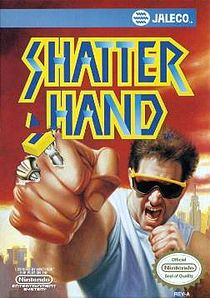- Shatterhand
-
Shatterhand 
Cover art of ShatterhandDeveloper(s) Natsume Publisher(s) Jaleco Distributor(s) Nintendo Composer(s) Iku Mizutani
Kouichi YamanishiPlatform(s) Nintendo Entertainment System Release date(s) Genre(s) Action/Platformer Mode(s) Single-player Shatterhand is a side-scrolling action game for the Nintendo Entertainment System developed by Natsume and published by Jaleco in North America and Europe in 1991. An alternate version of Shatterhand was released in Japan as a licensed game for the Family Computer based on the live-action superhero series Tokkyuu Shirei Solbrain (特救指令ソルブレイン Tokkyū Shirei Soruburein). However, the Shatterhand version, despite being released later and outside of Natsume's native market, was developed first.
Contents
Plot
Set in the year 2030, a group of military renegades known as Metal Command, led by General Gus Grover, are seeking to conquer the world by building an army of cyborg soldiers. Steve Hermann, a young police officer from the Bronx, ends up losing both of his arms during a skirmish with members of Metal Command. After the incident, Hermann is offered two specially developed cybernetic arms developed by the Law and Order Regulatory Division (L.O.R.D.) to replace the ones he lost. Hermann accepts the offer and becomes an agent codenamed Shatterhand, who is now tasked with the mission to defeat Metal Command.[1][2]
Gameplay
Shatterhand controls like most side-scrolling action games: with one button for attacking and another from jumping, while the d-pad is used to move left or right, as well as crouch. The player can also hang unto and stick to fences. The main character's primary weapon are his very own fists, which he can also use to intercept enemy bullets. There are two type of items that can be retrieved by destroying the item boxes scattered throughout each stage: gold coins and robot letters.[3][4][5]
The gold coins are used as currency that allows the player to obtain additional power-ups by standing over a certain kind of platform and crouching over it. These power-up platforms will indicate which power-up the player will receive, along with the coins needed to obtain it. There are three types of power-up platforms: the first will restore the player's health and costs 300 coins, the second will increase the player's attack power (changing the color of Shatterhand's vest to brown) and costs 100 coins, and the third gives out an extra life and costs 2000 coins.[6]
The other type of item that can be obtained by the player are robotic parts in the shape of the Greek letters α and β. When a robotic part appears, the player can change the letter by punching it. However, punching it too much will turn it into a large gold coin. After collecting three parts, a "robotic satellite" will appear floating alongside the player. The robotic satellite will attack alongside the player and can also be used to hover into the air by crouching and holding the A button. There are eight possible robotic satellites, depending on the combination of the letters collected, each with a different attack. For example, the ααβ robot fires laser beams, while αβα attacks with a sword. The robot can take damage from enemies and if it sustains too much, it will eventually be destroyed. If the player already has a robotic companion and picks up a new combination of letters, the new robot will replace the previous one. However, if the player picks up the same combination twice in a row while still maintaining the robot, Shatterhand will combine with the robot and will have more powerful attacks for a limited time period before reverting to his original state.[7][8]
There are a total of seven stages, dubbed "Areas", in Shatterhand. Area A, a factory stage, serves as the game's introductory stage, while the game's five subsequent stages, Area B to Area F, can be played in any order. The final stage, Area G, becomes accessible after the six stages are completed.[9][10][11][12] The player starts off the game with two extra lives and can obtain more throughout the game. If the player loses all their lives, the game will be over, but the player will be provided with unlimited chances to continue.[13]
Regional differences
The Famicom version, Tokkyū Shirei Solbrain, was published by a company called Angel, a now-defunct subsidiary of Bandai which specialized in the publication of licensed titles. The Famicom version follows the same storyline as the Solbrain TV series and features a different opening sequence from the one in Shatterhand, as well as a different ending. The graphics for most of the characters and items were changed as well. The most notable change is Area C, a carnival level in Solbrain, which was changed from an entirely different submarine level in Shatterhand.
References
- ^ Natsume. Shatterhand. Nintendo Entertainment System. Level/area: Instruction manual, page 6.
- ^ Natsume. Shatterhand. Nintendo Entertainment System. Level/area: Instruction manual, page 7.
- ^ Natsume. Shatterhand. Nintendo Entertainment System. Level/area: Instruction manual, page 8.
- ^ Natsume. Shatterhand. Nintendo Entertainment System. Level/area: Instruction manual, page 9.
- ^ Natsume. Shatterhand. Nintendo Entertainment System. Level/area: Instruction manual, page 10.
- ^ Natsume. Shatterhand. Nintendo Entertainment System. Level/area: Instruction manual, page 17.
- ^ Natsume. Shatterhand. Nintendo Entertainment System. Level/area: Instruction manual, page 15.
- ^ Natsume. Shatterhand. Nintendo Entertainment System. Level/area: Instruction manual, page 16.
- ^ Natsume. Shatterhand. Nintendo Entertainment System. Level/area: Instruction manual, page 11.
- ^ Natsume. Shatterhand. Nintendo Entertainment System. Level/area: Instruction manual, page 12.
- ^ Natsume. Shatterhand. Nintendo Entertainment System. Level/area: Instruction manual, page 13.
- ^ Natsume. Shatterhand. Nintendo Entertainment System. Level/area: Instruction manual, page 14.
- ^ Natsume. Shatterhand. Nintendo Entertainment System. Level/area: Instruction manual, page 18.
External links
Categories:- 1991 video games
- Natsume (company) games
- Nintendo Entertainment System games
- Nintendo Entertainment System-only games
- Video games set in 2030
Wikimedia Foundation. 2010.

